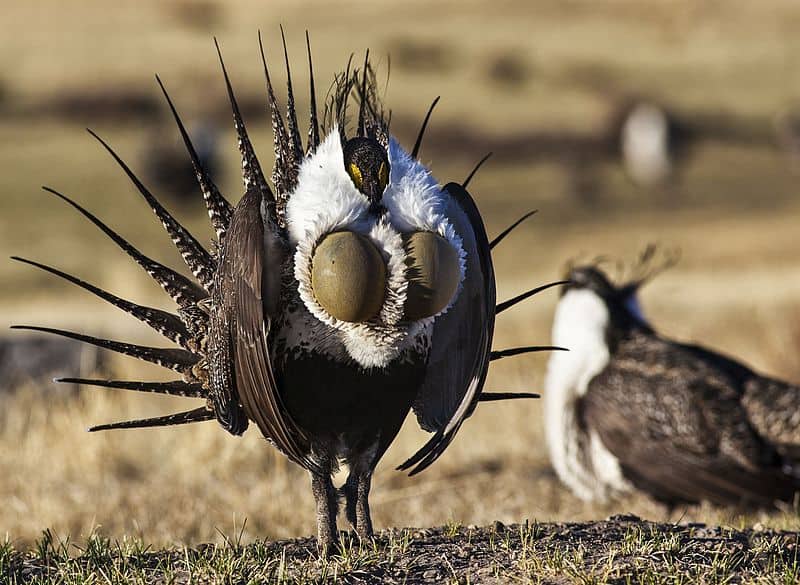Greater Sage Grouse Facts
- This intriguing product of Nature and evolution is most often referred to by the descriptive common name of the Greater Sage Grouse. The remarkable animal does have one other generally accepted title, though. That’s the notably far simpler term of the sagehen.
- Among scientific professionals, however, the creature holds a vastly different moniker. Though many such names pose difficulties for the layperson to pronounce, this one truly stands out. That’s because it holds the difficult technical title of Centrocercus urophasianus.
- The avian received that tongue-twisting term due to the efforts of the French ornithologist, Charles Lucien Jules Laurent Bonaparte. He accomplished the first recognition of the fascinating bird as a separate and distinct species. That feat occurred in the year 1827.
- It’s especially notable due to the fact that it consititutes the largest of its relatives on the entire continent on which it appears. Currently, researchers also acknowledge the existence of two sub-species of the impressive creature. Several others remain under consideration.
- Sadly, the population numbers of the Greater Sage Grouse continue to decline. That lamentable trend also seems to hold true throughout the entirety of its known range. The IUCN therefore presently lists it as Near Threatened on its Red List of Threatened Species.
- For the moment, habitat loss poses the most immediate ongoing threat to the continued existence of the impressive species. Other human-related dangers it faces include active hunting of the bird. Like all forms of life, though, it also faces the dangers of climate change.
Related Articles
Tawny Frogmouth
Greater Sage Grouse Physical Description
The preferred term of Greater Sage Grouse fits this winged masterpiece of Nature and evolution perfectly. Among its kind, it’s a veritable giant. The bird’s thus quite distinctive for multiple reasons, since it’s both the largest of its kind in its range, and also rather visually unique, as well.
Like many extant species on earth today, though, including birds, it displays a certain amount of the physiological characteristic of sexual dimorphism. In the specific case of this interesting animal, that natural trait manifests itself in terms of both pure size and general outward appearance.
Males attain significantly greater measurements than their female counterparts. In fact, these actually average roughly twice their mean size. The males average about 6 lbs (2.7 kg), while females only reach a mean weight of around 3 lbs (1.4 kg), though exceptional individuals occur.
Visually, the difference between the sexes developed as quite pronounced as well. The males of the animal usually present as grayish on the the upper body. Meanwhile, the breast and throat displays a much darker shade. Two yelllow sacs, capable of inflation, also appear on the neck of the male.
In addition to being so notably smaller, the female of the Greater Sage Grouse also displays a dramatically less colorful pattern. She most frequently presents a predominantly mottled gray-brown background on most of the body. Yet, the throat and stomach do show varying brown hues.
The two genders nevertheless still share at least some basic characteristics. In both sexes, the tails grow relatively long and sharply pointed. Intriguingly, the legs also possess a covering of feathers. This unique evolutionary trait extends all the way to the toes of the remarkable creature.
- Kingdom: Animalia
- Phylum: Chordata
- Class: Aves
- Order: Galliformes
- Family: Phasianidae
- Genus: Centrocercus
- Species: C. urophasianus
Greater Sage Grouse Distribution, Habitat, and Ecology
The fabulous Greater Sage Grouse evolved as native a moderately broad swathe of the surface of the globe. That precise location perfectly supports its needs. That’s true since the beautiful bird developed as endemic to a certain portion of what’s now the continent of North America.
Within that great zone of habitation, the majority of its numbers make their home inside the region comprising the western United States. A small part of its range does extend to southern parts of the nation of Canada, however. This includes the provinces of Saskatchewan and Alberta.
The large bird also displays specific preferences for its choice of habitat, too. The nature of that is reflected in the very name the avian bears. The specifically evolved avian lives almost exclusively in regions of sagebrush ecosystems, with the presence of some grasses and juniper trees.
By their very nature, these regions also mandate the existence of certain local environmental conditions. These, also, the bird requires to meet its needs. Those typically include a more arid climate than other areas. Higher altitudes additionally generally play a determining role this, as well.
The Greater Sage Grouse further possesses an extremely specific diet. This wonder consumes various species of sagebrush almost exclusively. Its habitat type therefore serves multiple purposes. Individuals also eat small quantities of herbaceous leaves from other plants, and insects.
It, in turn, faces its own share of natural predators. These generally include such even larger animals as bobcats, coyotes, badgers, and eagles, among others. Typically making its nests within the same region of sagebrush it feeds on, this sometimes provides a certain degree of protection.
Species Sharing Its Range
Check out our other articles on 6 Magnificent Carnivorous Plants, Thresher Shark, Whitehaven Beach, White Beaked Dolphin, Socotra Bluet, Vietnamese Mossy Frog, American Alligator

